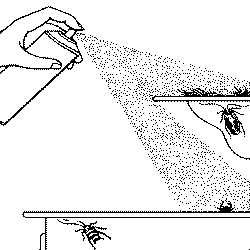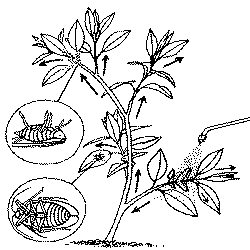Pesticide use in NSW
Understand how pesticides work, the risks associated with the different types of pesticides, and how the law sets out what you can do.
Pesticides
- control pests by physically, chemically or biologically interfering with their metabolism or behaviour.
- may be natural or synthetically produced
- are registered for use in NSW by the Australian Pesticides and Veterinary Medicines Authority (APVMA)
- are regulated under the Pesticides Act 1999 and Pesticides Regulation 2017.
See the legal definition of pesticide
Pesticides are often applied by spraying, fumigating and baiting. However, not all pesticides kill the target pest. Some act in other ways, for example
- repel or lure the pest into a trap
- sterilise the pest to prevent them reproducing
- cause leaf drop without killing the plant
- boost the action of another pesticide, for example, piperonyl butoxide adds to the effectiveness of pyrethrum in some insecticides.
‘Contact' pesticides are absorbed through the pest’s body surface. Examples include
- tetramethrin used in household fly sprays
- bipyridillium herbicides such as paraquat that are used on weeds

Contact pesticides have to reach their target directly to be effective.
Other pesticides move from the site of application to another area in the pest, for example
- insecticides that are absorbed by foliage and move through the plant to kill chewing or sucking insects
- blood anticoagulants in baits for rats and mice that move from the digestive system to the bloodstream

Systemic pesticides move from where they are applied to other parts of the plant to reach their target.
Pesticide persistence
Some pesticides are effective for long periods of time. For example
- triazine herbicides remain in the soil and kill emerging weeds over the lifetime of a crop.
- insecticide barriers that stop termites entering buildings are active for several years
How long a pesticide persists in the environment depends on a number of factors including
- how much is applied
- how it is distributed
- environmental factors such as temperature, moisture, soil pH and micro-organisms
- the chemical properties of the pesticide
Many modern pesticides act quickly and then degrade to non-toxic substances. This helps prevent pesticide build-up in crops or plants and animals that are not pests.
Pesticide resistance
One risk of using pesticides is that pests may develop resistance, which means the pesticide is no longer effective. Resistance generally develops when a pesticide is applied and a small percentage of the target organisms survive. These survivors pass their ‘pesticide survival’ characteristic on to each subsequent generation, making them more likely to be unaffected by the same pesticide.
To minimise resistance, pesticide users should
- closely follow the directions on the APVMA approved label (these may include specific resistance warnings)
- have a pest management strategy that does not solely rely on the use of pesticides, such as integrated pest management
- CropLife Australia have an informative video on how rotating pesticides can minimise pest resistance.
- AusVEG provide guidance on managing pesticide resistance in horticultural crops.
- The NSW Department of Primary Industries provides information on how pesticide resistance develops and how to manage it in specific crops. Use the search function to search for a crop or by typing in ‘pesticide resistance’.
Bactericides destroy, suppress or prevent the spread of bacteria. Examples include
- swimming pool chemicals containing chlorine
- products used to control black spot (bacterial blight) in gardens and orchards
Household disinfectants and some industrial disinfectants are not usually included in the definition of ‘pesticide’ as they clean objects rather than dispose of pests.
Fungicides are used to control or destroy fungi such as
- grey mould on grape vines and fruit trees
- downy mildew on cucumbers
Herbicides destroy, suppress or prevent the spread of a weed or other unwanted vegetation, for example, the herbicide glyphosate controls a range of weeds in gardens and bushland, and on farms.
Insecticides control many insect pests, including
- thrips
- aphids
- moths
- fruit flies
- locusts
Products used on animals to control external parasites are considered pesticides in NSW if they must be diluted or mixed with water. Products applied directly to animals without being diluted, and treatments that are injected or given internally, are classified as veterinary medicines and are regulated by the NSW Department of Primary Industries under the Stock Medicines Act 1989.
Rodenticides are chemicals used for controlling rodents such as mice and rats.
Baits may be 'ready to use', or are mixed with food. Different types of baits are available for
- large animals such as foxes and rabbits
- insects such as cockroaches and ants
- molluscs (snail and slug pellets)
Lures are chemicals that attract a pest to a pesticide. Food-based lures, for example cheese in a mousetrap, are not considered pesticides.
Genetically modified organisms (GMOs) have been genetically modified to make them more resistant to pests and diseases. For example, genetically engineered Bt cotton includes a gene from the Bacillus thuringiensis bacterium that protects the plant from bollworms.
GMOs used as pesticides are registered with the APVMA and subject to the same regulations as other pesticides. For more information about GMOs in Australia, see the Office of the Gene Technology Regulator.
Repellents repel rather than destroy a pest, for example, insect repellents repel insects such as flies and mosquitoes.
Registering living things as pesticides
A number of living organisms that can control pests have also been registered as pesticides. Examples include
- Rabbit Haemorrhagic Disease that has been used to reduce rabbit numbers
- bacteria that act as biological insecticides and control insect larvae, such as those of moths and mosquitoes
Many natural substances can be used as pesticides, such as extracts of pyrethrum, garlic, tea-tree oil and eucalyptus oil. When these are used as pesticides, they are subject to the same controls as pesticides produced synthetically.
Use pesticides only if absolutely justified. It is essential to carefully identify the pest you wish to control and fully consider all other options first.
Before using a pesticide, you must read the label or APVMA permit instructions, or have them read to you, so you
- know what precautions you need to take
- understand any limitations of using the pesticide, such as not applying it before rain or near waterways
- make sure it is the right pesticide for the pest you are targeting
You are legally required to always follow label directions or APVMA permit instructions.
If the product label does not include information about the pest and situation in which you want to use the product, you must find a product you can legally use. You can do this via
- the APVMA database
- asking pesticide manufacturers or suppliers
If you are using pesticides at work, ask the manufacturer or supplier for the material safety data sheet (MSDS), which provides further health and safety advice at no extra cost. For more information contact SafeWork NSW.

Myth: the Pesticides Act 1999 does not apply to the use of herbicides.
Fact: The legal definition of a pesticide under the Pesticides Act covers herbicides, insecticides, fungicides, rodenticides and many other types of substances. This misunderstanding arises because the term ‘pesticide’is sometimes wrongly used to describe insecticides only.
Myth: Pesticides made from natural substances or 'home brews' are intrinsically safer in all respects than synthetically produced or commercial pesticides.
Fact: All substances, whether synthetic or naturally derived, involve some degree of risk. For example, sodium fluoroacetate (1080)occurs naturally in some Australian plants but is a highly toxic substance used to kill pests such as rabbits, feral pigs, wild dogs and foxes.